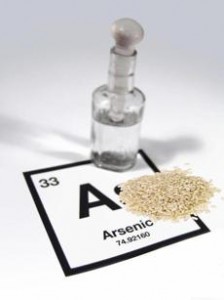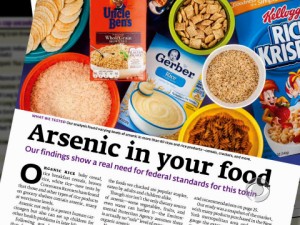 Even rice is not sacred or safe to eat anymore.
Even rice is not sacred or safe to eat anymore.
Guest Post By Dan Wellsich
Those of us who are old enough to have participated in the formative back-to-nature food movement of the 1960s and early 1970s sang the praises of rice; specifically brown rice. We consumed mass quantities of the stuff because we believed it was the healthiest and safest food on the planet; and that it, along with sprouts, nuts, and organic fruit, would guarantee us a long life. It now looks like we were wrong, and in our youthful exuberance, we may have actually given birth to children less brilliant than ourselves because we overdosed on brown rice.
Quiz: Is Your Body TOXIC? Take the Test...
(get your free personalized report)
For that, I’m so sorry. We meant well.*
It would seem that all rice – but mostly brown rice grown in Asia, Africa and South America – is loaded with trace amounts of both lead and arsenic, and we are being advised by Consumer Reports to curb our enthusiasm and limit our daily consumption of rice products, particularly regarding the amount we feed to our children in cereals, crackers and breads.

Because rice is grown in and absorbs ground water – and because we have so befouled the Earth now with heavy trace minerals, the unnatural by-products of man’s “progress” – it is quite likely that rice these days may be safer to throw at newlyweds than to eat at dinner. Even in Louisiana, Texas, Arkansas, California and Mississippi, where 93% of the rice consumed in the US is grown, rice can no longer be held up as the paragon of health some of us once believed it to be.
The FDA has been sanguine on the subject. They have been studying the issue since 2012, but have yet to make any official pronouncements about how much arsenic or lead is allowable, or how, or if, current levels should be controlled. The most current FDA advisory recommends no change in diet until they complete their studies, but we all know about FDA studies; not to mention their regulatory process.
Quiz: Is Your Body TOXIC? Take the Test...
(personalized report)
If we are to cut back on rice, that still leaves oatmeal, wheat, and barley as viable substitutes in the grain family. These spend less time being saturated by ground water, so while they, too, contain trace metals and insecticides along with more healthful minerals, they are generally safer and healthier.
What is the concentration of arsenic rice?
Rice and Rice Products Sample Analysis – September 2012 **
Average Amounts of Inorganic Arsenic by Product Category in mcg per serving
| Product | Average Inorganic Arsenic (iAs) | Range of iAs | Number of Samples |
| Basmati rice1 | 3.5 | 1.2 – 9.0 | 52 |
| Rice cereals | 3.5 | 1.5 – 9.7 | 32 |
| Rice Beverages2 | 3.8 | Trace – 4.1 | 28 |
| Rice cakes | 5.4 | 3.0 – 8.2 | 32 |
| Other Rice | 6.7 | 2.2 – 11.1 | 49 |
Are we safer eating US grown rice?
The most truthful answer here is “Yes, but…” It has been proven that rice grown in the US contains slightly less concentrations of lead and arsenic, but… it is not so easy to tell where the rice we buy has been grown. Most packaging does not include the country of origin, and buying rice in bulk out of open bins in ‘health food’ stores amounts to grabbing a surprise package out of a barrel.
How much rice is safe to eat?
Consumer Reports recommends the following as upper limits for children (age not specified; serving sizes are uncooked):
- Infant cereal: ¼ cup, one serving per day.
- Hot cereal: ¼ cup, 1 ¾ servings per week.
- Rice-based ready-to-eat cereal: 1 cup, 1.5 servings per week.
- Rice drink (milk, soy): Consumer Reports recommends you just don’t go there.
- Rice: ¼ cup, 1.25 servings per week.
- Rice pasta: 2 oz., 1.5 servings per week.
- Rice crackers: 8 – 9 crackers a day.
- Rice cakes: 1-3, 1 serving per week.
We will assume that Consumer Reports is suggesting we don’t feed our children rice cakes and rice crackers and rice pasta or any of the others in the same week or same day; it would be an awful lot of rice if we allowed our children all of these products in these amounts in a given day or week.
There are no similar recommendations (yet) for safe rice consumption by adults, so the ‘moderation in all things’ maxim is probably the best guideline to follow for the time being, at least until the FDA steps in more forcefully. So far it has only dipped a hesitant toe in the water on the subject.
A certain cynical group of statisticians point out that we humans have actually dropped a few IQ points on average over the past hundred years or so, and that it’s pretty much downhill for the species from here on because of our suicidal poisoning of the Earth. If the claim is true, then is it possible that rice may have been a leading contributor to our Darwinian devolution, along with water itself?
*Note: If my generation’s enthusiasm for brown rice gave birth to a dumber generation, my apologies here won’t count for much, but I personally apologize in any case to my own children. Of course, it might be that the rice we ate back then in such massive quantities was less loaded down with trace metals and arsenic than it is today.
Peace and love, in any case.
** FDA, Arsenic in Rice http://www.fda.gov/Food/FoodborneIllnessContaminants/Metals/ucm319870.htm
Other resources:
The Daily Green, “First Arsenic, Now Lead Found in Rice,” by Dan Shapley
http://www.thedailygreen.com/healthy-eating/eat-safe/lead-imported-rice-1304?click=main_sr
USA Rice, “Arsenic in Rice”, unattributed http://www.consumerreports.org/cro/magazine/2015/01/how-much-arsenic-is-in-your-rice/index.htm
